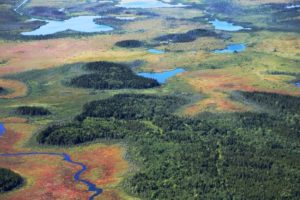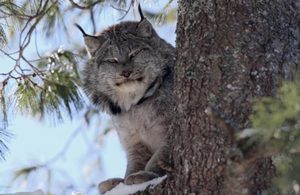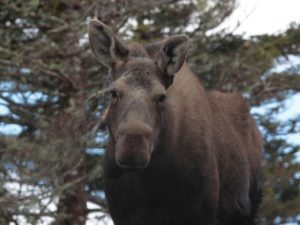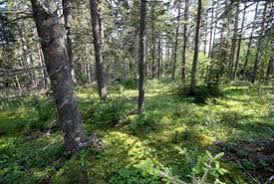Connecting Nature across the Chignecto Isthmus
By: Sandra Bender
I am 23 kilometers long with two coastlines. In addition to being a very important transportation link, I am recognized regionally, nationally, and internationally as a vital wildlife corridor. Indeed, I provide the only route for terrestrial wildlife to move in and out of Nova Scotia. Who am I?

Let me give you some additional details about myself. I am a narrow strip of land that joins Nova Scotia to New Brunswick and the rest of the continent. I have two distinct coasts – to the northeast is the Northumberland Strait and on southwest is the Bay of Fundy. I host the towns of Amherst, NS and Sackville, NB, the Trans-Canada Highway and an inter-provincial railway crossing. I am the Chignecto Isthmus, and ecosystem connectivity is vital to my health and prosperity.
Ecosystem connectivity refers to the ability of plants or animals to move through a landscape. Connected ecosystems maintain suitable habitats and allow my flora and fauna to move about as they need to survive and thrive. Greater connectivity across my ecosystem means fewer barriers to the small movements or grand migration of species. When people plan for connectivity in my ecosystem, regional biodiversity is protected as neighbouring ecosystems are linked. Without connected ecosystems, Nova Scotia could become an ecological island, isolated from New Brunswick and mainland North America. This could reduce the opportunity for migration and dispersal of terrestrial wildlife between the provinces.

I am home to many species including black bear, moose, fisher, lynx, coyote, red fox, osprey, bald eagle, eastern white cedar, black ash, skunk cabbage and a number of rare or uncommon species, including 56 species of birds and 101 species of plants. Many of the wildlife living here need to move about to forage, nest, and reproduce.
When ecosystems are connected, sometimes through natural or human-made movement corridors, links between habitats allow these and other species to access the resources they need to survive. This is especially important for species that are heavily impacted by habitat fragmentation, when human activities such as residential development, road construction, agriculture, and intensive forestry separate habitats. Sadly, all of these activities take place at a significant rate on the Isthmus, resulting in an increasingly fragmented ecosystem.

As New Brunswick and Nova Scotia develop infrastructure, the impacts of climate change will be felt across the Isthmus if connectivity isn’t protected. Restricting movement and decreasing ecological connectivity could pose risks for wildlife, and will likely limit the ability of plants and animals to adapt to climate change.
CPAWS NB and CPAWS NS want to see me as healthy as possible by establishing and improving my connectivity. They have worked with each other, as well as local residents and researchers, to identify opportunities for greater connectivity across my area. This is collaboration for connectivity. If you ask me, I don’t think one can happen without the other.
Thankfully, my humans get it. What encourages me most is the wide range of people involved in the efforts to keep my many species and habitats thriving. Land trust organizations active on the Isthmus including our friends at Ducks Unlimited Canada, the Nature Conservancy of Canada, and the NB Community Land Trust have worked with landowners and governments to protect me.

Local residents, hunters, trappers, landowners, and conservationists helped to identify and provide feedback on areas that are important to wildlife movement. They also provided valuable information on changes and risks to this movement. For example, community members have suggested that connectivity conservation efforts should focus along the northern portion of Highway 16 in New Brunswick to create a wildlife “movement funnel” across the Isthmus. This area represents some of the largest patches of habitat in the NB-NS border area and is critical to any projected connectivity route. So many people working together in my best interest is heartening!
Without greater protection it will be much harder for species to withstand the pressures of habitat destruction and fragmentation, increased competition for limited resources, and other stressors. All of these factors create isolated “islands” that affect wildlife’s ability to survive. Protecting wilderness within connected ecosystems is critical. This is why CPAWS NB is calling for more protected areas in New Brunswick, and more protected areas that are ecologically effective and strategically placed to allow for ecosystem connectivity that supports our local wildlife.
We know that nature and wildlife are important to New Brunswickers. Add your voice to our e-letter campaign and tell your MLA that protecting nature in New Brunswick is important to you!
References
MacDonald, A. & Clowater, R. (2007). Natural Ecosystem Connectivity Across the Chignecto Isthmus – Challenges and Opportunities. A collaborative project of CPAWS New Brunswick and CPAWS Nova Scotia. Retrieved November 5, 2018: https://www.cpawsnb.org/wp-content/uploads/2017/12/ChignectoFinalVersionJune06v2.pdf
Nature Conservancy Canada. (2018). Moose Sex Project (Chignecto Isthmus).
Retrieved November 5, 2018: http://www.natureconservancy.ca/en/where-we-work/nova-scotia/featured-projects/Chignecto-Isthmus.html
Conservation Corridor. (2018). Corridors in Conservation. Retrieved November 5, 2018: http://conservationcorridor.org/corridors-in-conservation/
Header photo by Julie Reimer

